MZ's Lessons: The Card Pool
The Gwent Card Pool - All the Stats You Might Desire (0.9.11 - Agile Patch)
Introduction
Gwent is a game that puts a huge emphasis on synergy. Most of the times, it is not beneficial to just smash together the best individual cards of a faction. Getting a feeling of what is in the game regarding different card types, keywords and mechanics can be cumbersome though. The collection manager has a search function implemented, but to get a feeling of which strategy might be worth following while deck building can feel cumbersome. Therefore, I tracked every stat imaginable and made a huge table. I extracted the information spread throughout the collection and compressed it into the charts you can find in this article. Those graphs and data should give you an overview of multiple aspects of the game you might want to consider when building a deck.
Factions
As in all card games, in Gwent, there are two different kinds of cards. There are the collectible cards, and there are the uncollectible cards or “tokens”. The latter are the ones that derive from other cards and cannot be put in your deck in the first place, and neither are acquirable from kegs.
Among all factions, except Neutrals, there is almost the same number of cards available with slightly more in Monsters and Nilfgaard than in the other three factions [Fig. 1a; further details see Fig. 3]. Tokens are much more prevalent in the Neutral and Monsters faction compared to the others [Fig 1b]. Alternate arts are very scarce so far with the most available in Northern Realms (NR) and all being Bronze cards, either being Common or Rare [Fig. 1c].
Fig 1a-c
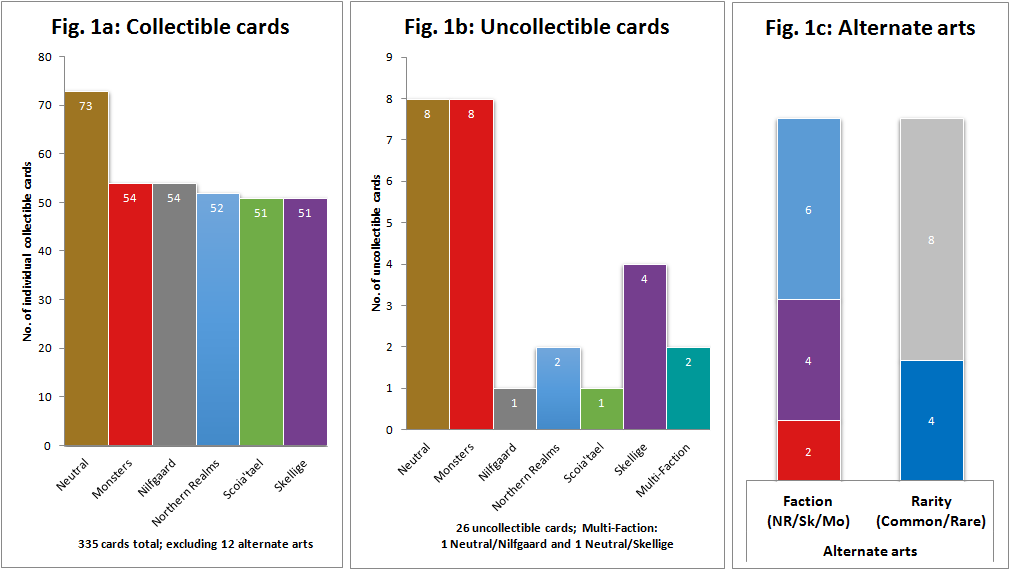
Rarities and Groups
Gwent has a twin system implemented regarding rarity discrimination. There is the usual rarity ranking differentiating into Common, Rare, Epic, and Legendary cards. This system is what you know from most TCGs out there. The other system, the groups, divides into Bronze, Silver, Gold, and Leader cards. Simply put, Bronze cards include Commons and Rares while Silver cards represent Epics. Golds and Leaders are considered Legendaries.
The reasoning behind this system is based on deck building on the one hand and crafting on the other hand. As you know, decks are restricted to 4 Golds, 6 Silvers with no limit to Bronzes despite the maximum deck size of 40 cards. Each deck has in fact 26 cards (not 25) as everyone has to choose one Leader. To be honest, a restriction based on Legendaries and Epics would have worked too, but grouping Commons and Rares together make some sense for the least.

The distribution of groups looks very straightforward [Fig. 2a]. There are around 70 Golds while there are 40 more Silvers and roughly an additional 40 Bronzes. Finally, there are 15 Leaders available, 3 for each non-neutral faction. Strangely, Nilfgaard got two more Golds than all other non-neutral factions, and both Monsters and Nilfgaard have one more Silver card in their pool [Fig. 3].

Now, let’s take a look at rarities. For individual cards [Fig. 2b], meaning each different card without taking into account that three copies of each card can be used, and also excluding alternate art cards. There is a surprisingly homogenous distribution of rarities with Commons being even less common (pun intended) than Legendaries. Surprisingly though, Epics have the highest number of individual cards and Legendaries and Rares are even-numbered. The picture changes if we take into account that you can use up to three copies of Commons and Rares for a deck, and when including alternate art cards (full collection) [Fig. 2c]. The number of Epics and Legendaries stays the same but the amount of Commons and Rares available for building a deck increase more than threefold.
Positions and Loyalities
After the most recent “Agile Patch” (0.9.11), there are only a few units left that are row-locked. 230 are agile, 215 true agile units and 15 leader cards. Leader are considered agile even though they are not labeled regarding their position in any form. Additionally there are 44 special cards which also do not have a position tag. Subtracting those cards from the total of 335 cards actually in the game there are 61 row-locked units left. Of those, the least amount are locked to Ranged and most to Siege (Fig. 4a). Skellige is the faction with most non-agile cards (15) whereas the least amount are present in Northern Realms followed by the Neutral faction with 6 and 7 respectively (Fig. 4b).
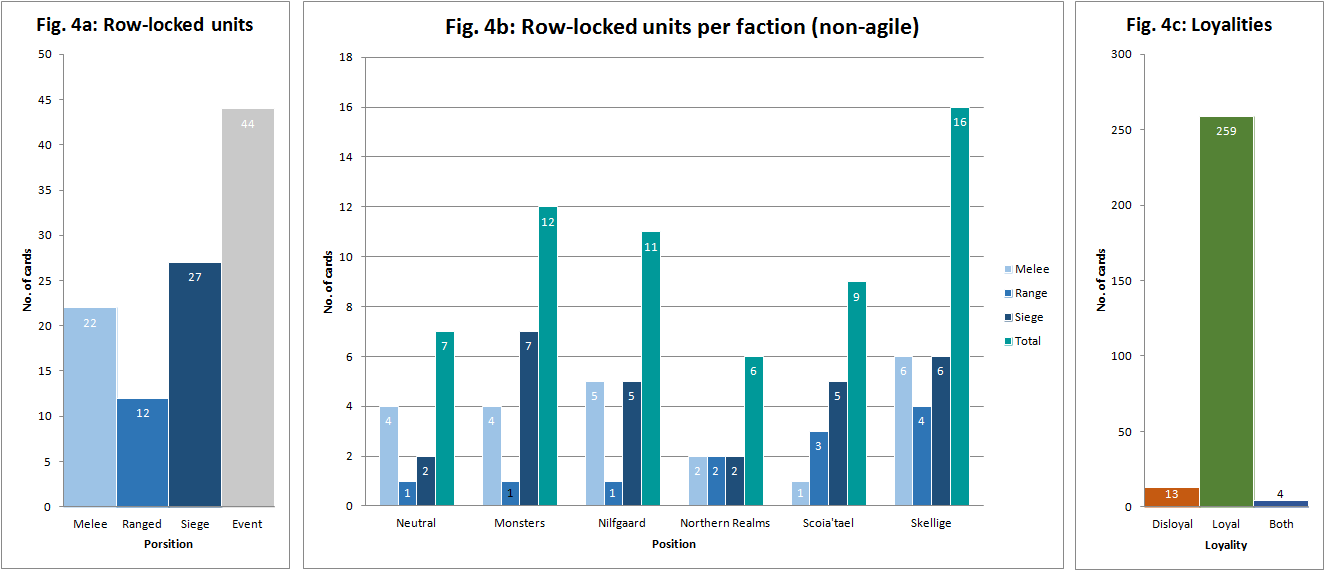
Finally, units are differentiated not only in which row they can be played, but on which side of the board as well. Those that are restricted to your side are called “loyal”, those that are limited to the opponent’s side “disloyal”. The latter category are also part of the “Agent” group. Those that can be played on both sides belong to the “Double Agent” group (Fig. 4c)
Card Strength
When looking at the strength of the cards, we see a nice Gaussian distribution of the units (1-14 strength) except the peak at zero strength. This peak caused by the high number of Specials which have zero strength attached. The highest raw powered card is Hjalmar, followed by Geralt. There is not much more to read from the graph as the power a card lends to the board is not solely defined by the raw strength (Fig. 5).
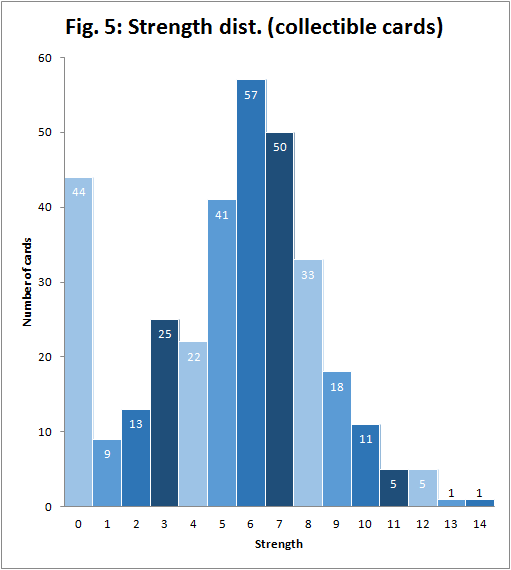
Card Types (Tribes)
Card types (or tribes) are subcategories of Specials and Units. Each card can carry more than one, up to a maximum number of five, with the majority having 2 or three [Fig. 9a]. Having no tribe is possible but there is only one card in the game with none – Kambi. I made four different graphs for card types, two for Specials and two for Units with a depiction of absolute and relative measures for both individually as units, as well as Specials, which do not share the same pool of tags. This separation into four rather than two graphs was made to enhance readability. As you can see, there are different tribes predominantly or sometimes exclusively present in particular factions (e.g., Elf in Scoia’tael with only one Neutral Elf - Avallac’h). This separation can help you identify certain synergies, especially when looking at support from Neutrals [Fig 6a-b].


Specials are almost exclusively Neutral (86%) with just one Silver Special available for the other classes except Nilfgaard which has Assassination as an additional Gold Special [Fig. 7a-b].
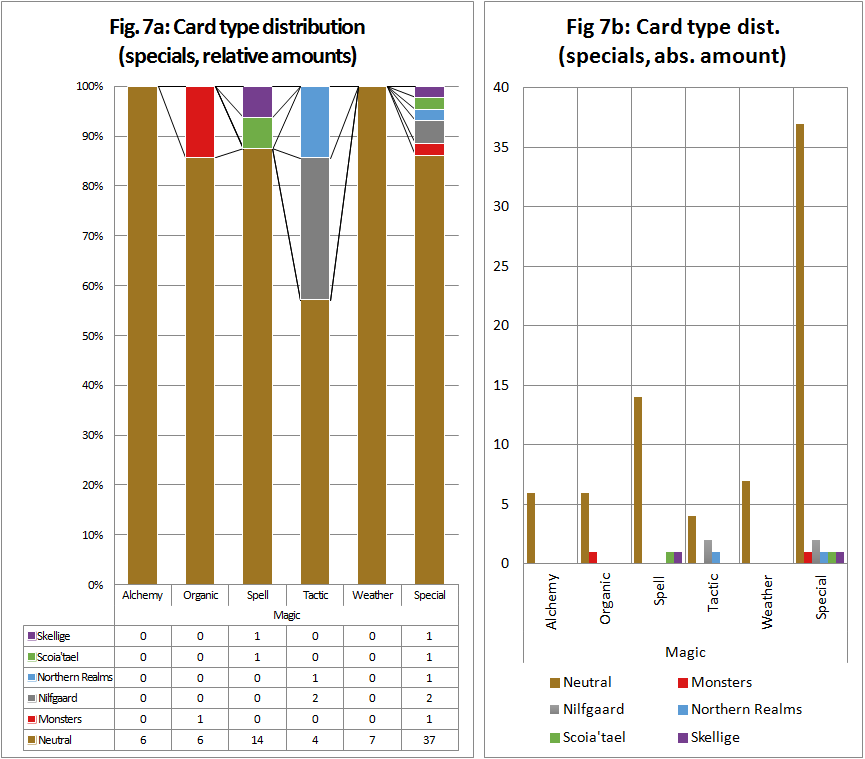
Keywords
Keywords represent standardized phrasing for card’s abilities. When I was first exposed to Gwent, I was amazed by the number of keywords available. I favor them a lot as they provide a convenient way of transmitting information easily. As with tribes, certain keywords tend to be more prevalent in certain factions. For example, “Spying” is exclusive to Nilfgaard whereas “Deploy” or “Boost” are omnipresent [Fig. 8a-b]. Again, each card can carry more than one keyword (0-7 keywords). At the moment, there are only a few that carry none (N=9) and even less that carry six or more (N=6). The vast majority has two keywords attached (N=123) with a similar number having either one or three (N=137) [Fig. 9b].

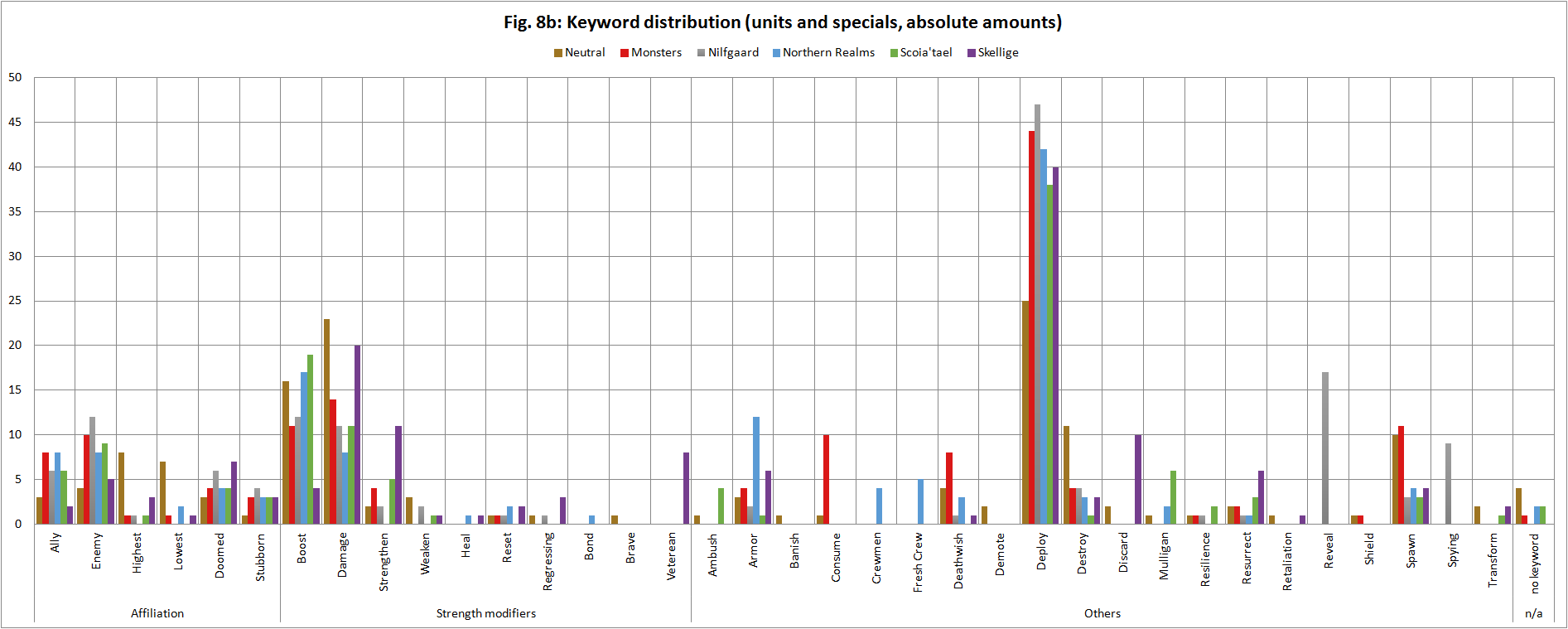
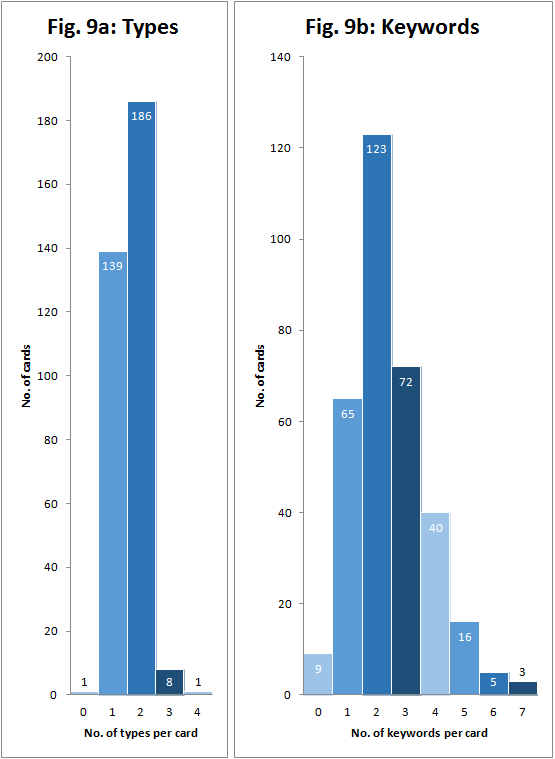
Oddities
While putting together the table to make the graphs and analyzing it, I found a few strange things which I will list in this section. I will provide a comment to every finding.
· Move is not a keyword. Making it a keyword poses some difficulties as you can move units on the board and move cards, e.g., to the graveyard. My suggestion would be something like move and displace as two distinct terms.
· Draw and shuffle are not keywords, in contrast to discard.
· Leaders have no position tag. Personally, I feel they should be “Agile”.
· Why are there more cards for Monsters and Nilfgaard in comparison to the other factions, especially two (!) more Legendary ones for the latter? Will we see this balanced out eventually?
· Additionally, Nilfgaard is the only faction with a second faction-locked Special.
· There are no alternate art cards for Monsters and Scoia’tael.
· Coral’s card text is not in line with keywording. It reads: TURN a (…) into a Jade Figurine. It should be worded with the use of the “transform” keyword like the text of Artifact compression which reads as follows: TRANSFORM a (…) into a Jade Figurine.
· Birna Bran “applies” Skellige Storm to a row rather than “spawn” Skellige Storm and “banish” it directly. There is reasoning why they did word it as is over the abovementioned. It is shorter and they did not want the Skellige Storm to be resurrectable. Nonetheless, my suggestion would be more in line with keywording.
· Kambi the only card that has no card type attached. Why, we wonder? Poor rooster, at least he is golden!
Conclusion
Ok, that is it so far. I hope you found this kind of analysis helpful. I, for my part, found it interesting enough to keep me going although statistics are normally a boring task to deal with. Knowing what is there to work with can help a huge amount in the process of developing a deck strategy. But more importantly, what do you think? Please let me know by leaving a tweet @OtakuMZ1978.
If there is any question left open, or in case I missed an important aspect; I encourage you to bring it up! I will gather all suggestions and will follow it up with another round of stats and graphs.
